 |
| A final hug, a minute before Wondertime's departure from Marina de La Paz. |
But what of longer periods of time spent at sea, under sail? Unfortunately, I can’t offer my perspective on what it is like to be underway for longer than eight days (that is the longest period Windy and I experienced).
But our friends are out there now, two families aboard two boats, near the start of journeys expected to last weeks. Wondertime and Convivia are at the same time crossing the largest body of water in the world, bound for a South Pacific island. In fact, for folks completing a circumnavigation of the world, the leg between the west coast of the Americas and the South Pacific is the largest body of water that must be crossed. These two families are sailing over 3,000 miles to their destination, a relatively uncommon feat in the world of cruising families.
 |
| The Convivia crew: Ruby, Tucker, Miles, and Victoria (left to right), as we remember them from La Cruz. |
It may be easier to imagine it if you follow along: Sara on Wondertime and Tucker on Convivia are each chronicling their crossings as they unfold, on their blogs (connecting to the Internet via their on board, single sideband radios). They departed within a day of one other, but from cities hundreds of miles apart; their trips are independent.
Wondertime and Convivia are both about a week into their voyages and I eagerly await each new post. So far, fresh fruit and vegetable stores are dwindling fast. Convivia is slowed significantly by the loss of their light-air sail on day two.
So while you sleep tonight, while you’re at work tomorrow, while you make that dentist appointment for two weeks from now, and after that appointment has passed, two families on two small boats continue moving across a vast, empty ocean, nonstop, day and night. Aboard each boat, the trade winds are pushing, keel ballast is resisting, and they are making steady progress across the Pacific Ocean—at about the speed of a marathon runner.
--MR |
| Windy and the girls watch from the end of the dock as Wondertime departs. |




































